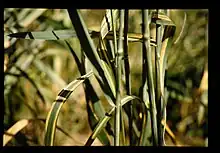Cephalosporium gramineum
Cephalosporium gramineum syn. Hymenula cerealis is a plant pathogen that causes cephalosporium stripe of wheat and other grasses. It was first reported in Japan in 1930.[1] The disease can cause yield losses of up to 50% by causing death of tillers and reducing seed production and seed size.[1] The disease causes broad yellow or brown stripes along the length of the leaf and discolouration of the leaf veins.[1] The fungus spreads through the soil, and enters the plant through wounds in its roots.[1] Early planting of winter wheat when the soil is warm gives a greater root system more subject to root breakage when the soil heaves affording more infection sites. Phosphate fertilizer and high moisture further exacerbate this condition.[2][3] The symptoms are caused by the fungus invading the plants' vascular tissue.[4] The fungus also produces a toxin which causes stunting of the plant and interferes with development.[5] A glucopolysaccharide also appears to inhibit fluid movement in wheat.[6]
| Hymenula cerealis | |
|---|---|
 | |
| Cephalosporium gramineum | |
| Scientific classification | |
| Kingdom: | |
| Phylum: | |
| Class: | |
| Subclass: | |
| Order: | Incertae sedis |
| Family: | Incertae sedis |
| Genus: | |
| Species: | H. cerealis |
| Binomial name | |
| Hymenula cerealis | |
| Synonyms | |
Very little natural resistance to the disease is seen in wheat. Control measures include crop rotation for 2–3 years in areas where the disease has become a particular problem.[1][4] Currently, no options exist for controlling the disease through the use of fungicides.[5]
References
- Lipps, Patrick. "Cephalosporium Stripe of Wheat". The Ohio State University. Archived from the original on 2008-04-13. Retrieved 2008-09-21.
- Pool & Sharp, Phytopathology: 57:1008 (1966)
- Pool & Sharp; Plant Disease Reporter 53(11):898 (1969)
- "Cephalosporium Stripe". Washington State University (WSU). 2017. Retrieved 2023-02-15.
- Karrow, R.S.; Powelson, R.L.; Koepsell, P.A. (1993). "Cephalosporium Stripe". Oregon State University. Archived from the original on September 5, 2006. Retrieved 2008-09-21.
- Pool, R.A.F. & Sharp, E.L., Phytopathology:59(11),1763 (1969)